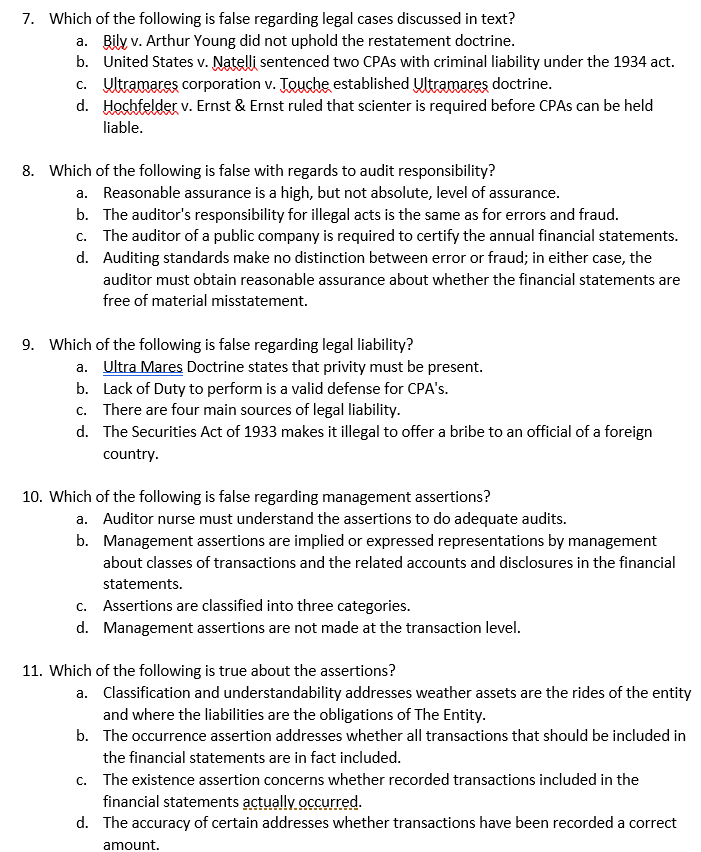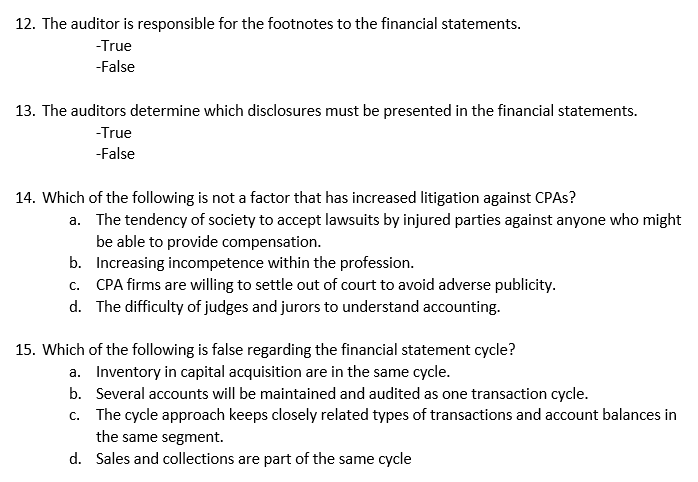


1. Which of the following is false regarding common and federal securities laws? a. The securities act of 1933 deals only with the reporting requirements for companies issuing new securities. b. -Rule 10-5b of the securities exchange act of 1934 is also known as the antifraud provision. C. -Ultramares doctrine states that ordinary negligence is insufficient for liability to third parties because of the lack of privity of contracts. d. A scienter is a specialist used in Rule 10-5b investigations. 2. The engagement letter explains management and auditor responsibilities. -True -False 3. An audit generally provides no assurance that illegal acts that do not have a direct effect on the financial statements will be detected. -True -False 4. Which of the following is false regarding audit objectives? a. The term audit objectives refers to transaction-related, balance related, and presentation and disclosure related audit objectives. b. It is usually practical for Auditors to obtain complete Assurance about the correctness of accounts receivable. C. Presentation and disclosure is an audit objective. d. Several audit objectives must be meant for each account balance. 5. The auditor's audit objectives follow and are closely related to management assertions. -True -False 6. Which of the following is false regarding legal liability? a. Foreseeable users are users the auditor should have reasonably been able to foresee as likely users of the client's financial statements. b. The SEC has the authority to sanction. C. The sarbanes-oxley ACT requires the Auditors to certify the annual financial statements filed with the SEC. d. Rule 10/5 B of the Securities Act of 1934 is often called the anti-fraud provision. 7. Which of the following is false regarding legal cases discussed in text? a. Bily v. Arthur Young did not uphold the restatement doctrine. b. United States v. Natelli sentenced two CPAs with criminal liability under the 1934 act. C. Ultramares corporation v. Touche established Ultramares doctrine. d. Hochfelder v. Ernst & Ernst ruled that scienter is required before CPAs can be held liable. 8. Which of the following is false with regards to audit responsibility? a. Reasonable assurance is a high, but not absolute, level of assurance. b. The auditor's responsibility for illegal acts is the same as for errors and fraud. C. The auditor of a public company is required to certify the annual financial statements. d. Auditing standards make no distinction between error or fraud; in either case, the auditor must obtain reasonable assurance about whether the financial statements are free of material misstatement. 9. Which of the following is false regarding legal liability? a. Ultra Mares Doctrine states that privity must be present. b. Lack of Duty to perform is a valid defense for CPA's. C. There are four main sources of legal liability. d. The Securities Act of 1933 makes it illegal to offer a bribe to an official of a foreign country. 10. Which of the following is false regarding management assertions? a. Auditor nurse must understand the assertions to do adequate audits. b. Management assertions are implied or expressed representations by management about classes of transactions and the related accounts and disclosures in the financial statements. C. Assertions are classified into three categories. d. Management assertions are not made at the transaction level. 11. Which of the following is true about the assertions? a. Classification and understandability addresses weather assets are the rides of the entity and where the liabilities are the obligations of The Entity. b. The occurrence assertion addresses whether all transactions that should be included in the financial statements are in fact included. C. The existence assertion concerns whether recorded transactions included in the financial statements actually occurred. d. The accuracy of certain addresses whether transactions have been recorded a correct amount. 12. The auditor is responsible for the footnotes to the financial statements. -True -False 13. The auditors determine which disclosures must be presented in the financial statements. -True -False 14. Which of the following is not a factor that has increased litigation against CPAs? a. The tendency of society to accept lawsuits by injured parties against anyone who might be able to provide compensation. b. Increasing incompetence within the profession. C. CPA firms are willing to settle out of court to avoid adverse publicity. d. The difficulty of judges and jurors to understand accounting. 15. Which of the following is false regarding the financial statement cycle? a. Inventory in capital acquisition are in the same cycle. b. Several accounts will be maintained and audited as one transaction cycle. C. The cycle approach keeps closely related types of transactions and account balances in the same segment. d. Sales and collections are part of the same cycle









